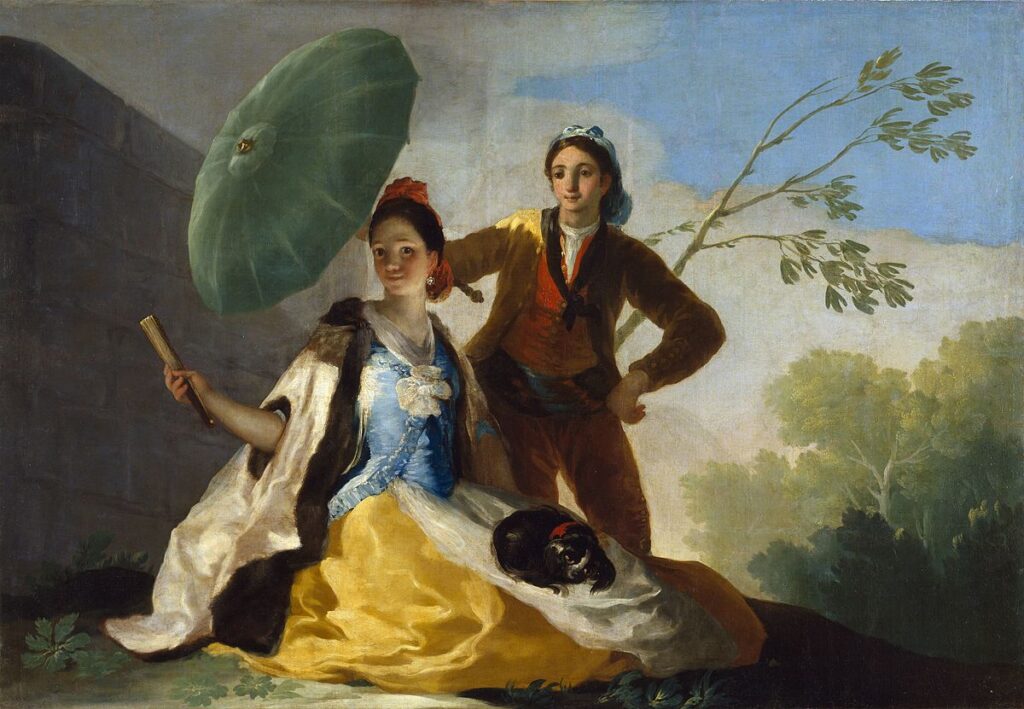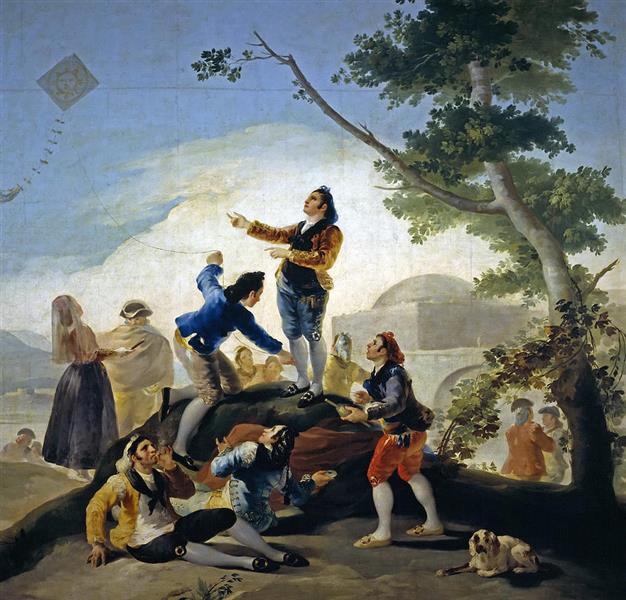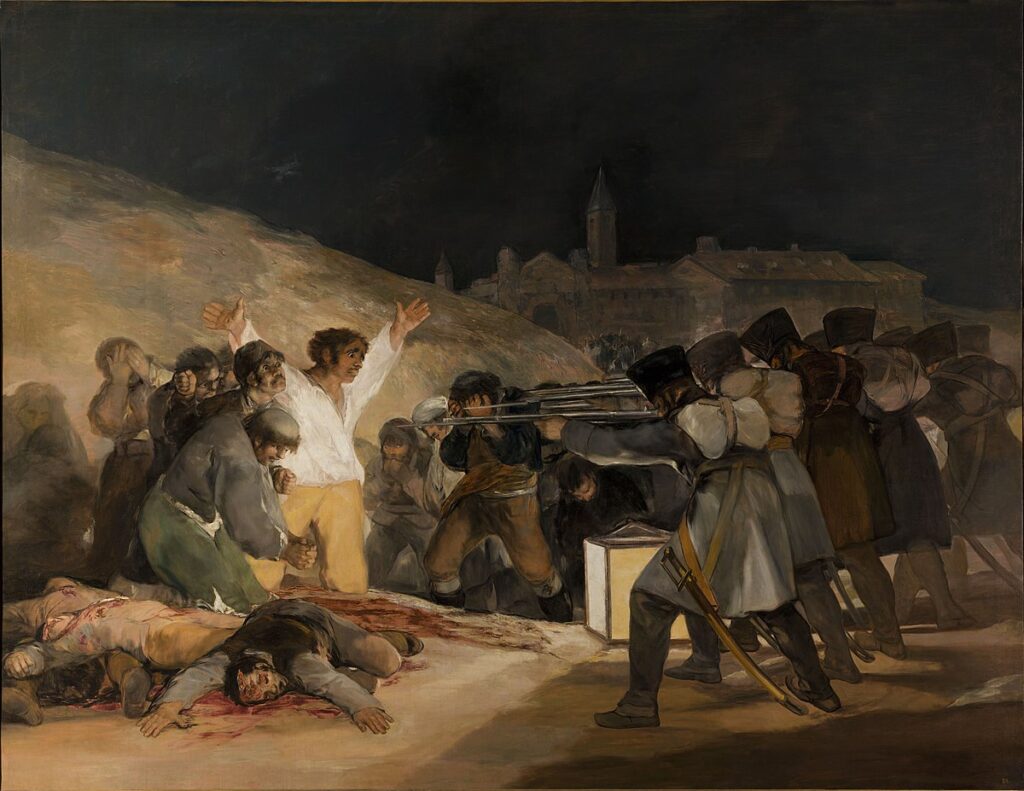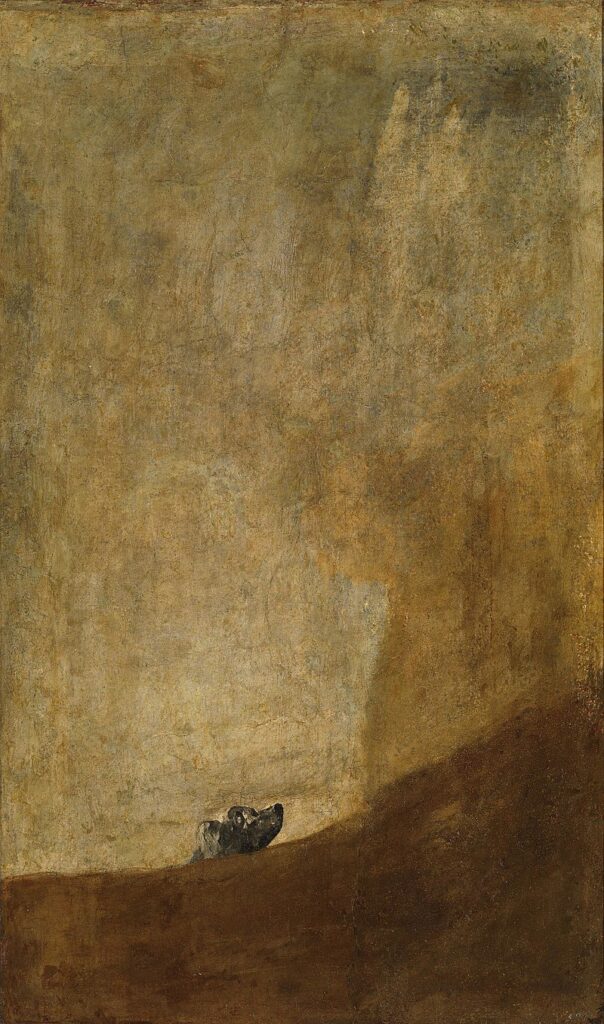Francisco Goya’s artwork was regarded as unique for its time because he did not try to beautify the people he portrayed or depict them in a manner that they would necessarily like. Instead, he painted as he saw them. This renowned Spanish painter was a notable figure of the Romanticism movement. Some of the most famous paintings by Goya include his Black Paintings, as well as Goya’s portraits, which were often considered harshly realistic. In this article, we will discuss a few of the most notable Francisco Goya paintings.
Renowned Francisco Goya Paintings
Francisco Goya’s artworks included still lifes, landscapes, self-portraits, and mythical scenes. As a member of the Romanticism movement, the Spanish painter often let his works be dictated by his emotional state, and Francisco Goya’s paintings often reflected his tumultuous experiences. The majority of Goya’s professional life was dedicated to working for royalty and aristocrats. Let’s learn a bit more about this famous Spanish artist’s life before checking out a few notable Francisco Goya artworks.
An Introduction to the Famous Spanish Painter Francisco Goya
| Artist Full Name | Francisco José de Goya y Lucientes |
| Nationality | Spanish |
| Date of Birth | 30 March 1746 |
| Date of Death | 16 April 1828 |
| Place of Birth | Fuendetodos, Spain |
Goya was only 14 years of age when he started his apprenticeship under a respected artist from Naples, José Luzán. In 1773, the Spanish painter married Francisco Bayeu’s sister. Bayeu was regarded as the court’s greatest artist and was able to get Goya a job in the royal tapestry factory. In 1780, he was accepted into Madrid’s Academia and subsequently appointed its deputy director five years later. Goya’s portraits were regarded as the most highly revered part of his oeuvre by his contemporaries, obtaining his first notable commissions for portraits from Infante Con Luis and Conde de la Floridablanca in 1783. Soon after, the Spanish painter grew to be regarded as a significant portrait painter of notable figures within Madrid’s high society. He would even become the King’s portrait painter and subsequently a court painter, appointed by Charles IV in 1789. Goya painted some of his most renowned artworks during the period of the Napoleonic wars, at which time his palette and themes darkened dramatically. During his later years, he also produced a series of works straight on the walls of his home, known today as his Black Paintings.
Our List of the Most Notable Francisco Goya Paintings
The unique ability of Francisco Goya’s artwork to mix historicity with emotions is well documented. His career spanned a turbulent period in Spanish history, and Francisco Goya’s paintings are renowned for their revolutionary themes. There are also many paintings by Goya featuring themes such as superstition and magic. Here are a few of our favorite Francisco Goya paintings.
The Parasol (1777)

| Date Completed | 1777 |
| Medium | Oil on canvas |
| Dimensions (cm) | 104 x 152 |
| Location | Museo del Prado, Madrid, Spain |
King Charles IV commissioned this painting for his Royal Palace’s dining room in 1777, a couple of years after Goya was appointed the court painter of Spain. The format and perspective of this piece suggest that it was meant to hang over a window. This Goya artwork portrays a scene of leisure in which a lady is being protected from the gusts of an approaching storm by a man holding a parasol. A cat can be seen sleeping on the lap of the woman who appears to be smiling at the viewer.
The woman is dressed in typical French clothing, with bright silks dominating the blue blouse with an enormous bow on the front and a golden-colored dress beneath. She is also portrayed holding a fan with her left hand. Her attendant is dressed more like a commoner, yet the clothing is still of good quality. The warm colors of their clothing, combined with the bright sunlight on the right-hand side of the panel, add to the overall impression of contentment in this Francisco Goya artwork. Its pyramidal arrangement, with humans in the front, demonstrates how Italian painting influenced Goya along with his perfect technique of painting shadows and light.
The Kite (1778)

| Date Completed | 1778 |
| Medium | Oil on canvas |
| Dimensions (cm) | 269 x 285 |
| Location | Museo del Prado, Madrid, Spain |
This Francisco Goya artwork portrays a group of young people who have traveled to the countryside to fly a kite. The lovers that can be seen located behind the main group demonstrate that the theme is only an opportunity for the Spanish painter to depict the flirtation and gallantry characteristic of Majo society. This painting features a lovely countryside with a brilliant blue sky and lush vegetation in the foreground. It’s a cheerful composition that presents an appealing portrayal of rural life outside of the bustling metropolis.
The various people portrayed are well-dressed, implying an affluent background, as most individuals during this era would not have had enough time for leisurely activities. The kite can be seen floating on the canvas’s left-hand side, and the cord is being held by a man who is positioned on a mound. The building that can be seen behind the people is thought to be an observatory that was never built but had been contemplated at the time. While some of the people present are watching the kite, others are either sitting or standing around enjoying their time in the country.
Witches’ Sabbath (1798)

| Date Completed | 1798 |
| Medium | Oil on canvas |
| Dimensions (cm) | 43 x 30 |
| Location | Museo Lázaro Galdiano, Madrid, Spain |
The artwork portrays a group of witches celebrating a Sabbath, which is a ceremony related to witchcraft. The Spanish painter created a gloomy and foreboding mood by depicting the witches in dimly lit murky tones against a dark night sky. The witches appear organized in a tangled mass as if captured in the middle of a wild celebration in the composition. The image also depicts children who have been sacrificed to the devil, with some portrayed dead, hanging from stakes in the backdrop, and one lying near the feet of the women.
His application of color and light is especially noteworthy, with the moon’s ghostly illumination shining on the surroundings and creating deep shadows. The ominous figure of the goat dominates this haunting scene, his horns filled with garlands of oak leaves and his hooves outstretched. This Goya artwork is noteworthy for its disturbing topic, reflecting the fears around witchcraft in the artist’s era. While many people at that time were concerned about the effects of the devil, the Spanish painter felt that everything else paled in comparison to what humans were capable of.
Naked Maja (1800)

| Date Completed | 1800 |
| Medium | Oil on canvas |
| Dimensions (cm) | 97 x 190 |
| Location | Museo Nacional del Prado, Madrid, Spain |
This highly controversial artwork is regarded as one of Goya’s greatest. The Spanish painter most likely created it for Manuel de Godoy, a Spanish nobleman. Godoy possessed a number of artworks of naked women, which he displayed in a secret cabinet designated to this subject. The woman’s pubic hair is visible, which was deemed to be inappropriate at the time. Yet, this painting is more than just an object of masculine desire. Here, the artist may be depicting the boldness of Spanish females of the time while also delving into the taboo issue of feminine sexuality.
She is portrayed as unapologetically herself, appealing, but on her own grounds. According to legend, the woman portrayed in this painting is the Duchess of Alba, although the model has alternatively been determined to be Godoy’s mistress, Pepita Tudó. She is not sleeping, nor does she pretend to be unaware that she is being watched. In fact, she displays herself without guilt, placing her arms behind her head, her pubic area the focal point of the scene. Visitors to Godoy’s private study praised her as the pinnacle of feminine beauty; generations afterward regarded her as a symbol of Spanish women.
Charles IV of Spain and His Family (1801)

| Date Completed | 1801 |
| Medium | Oil on canvas |
| Dimensions (cm) | 280 x 336 |
| Location | Museo del Prado, Madrid, Spain |
In 1800, Goya was appointed the highest position that a Spanish painter could reach, the first court painter. He began working on this group portrait soon after his appointment. As the title of Goya’s artwork suggests, it is the portrait of King Charles and his family, all decked out in their finest clothing and jewelry. It has been claimed that the Spanish painter was actually satirizing the people he was depicting, but this has been disregarded by critics as absurd, as you wouldn’t be able to continue doing your work as a royal portraitist if you were mocking the individuals you were working for.
The familial connection of the royal family, as well as the queen’s primary position as its matriarch, are evident in Goya’s artwork. She emanates vitality while surrounded by her relatives. The artwork also depicts the King’s wife and his eldest son, later to become Ferdinand VII. The portrait is set in Goya’s studio, with the Spanish painter present, appearing to the left of the canvas. It has often been compared to Diego Velázquez’s Las Meninas (1656), due to the similar subject matter, composition, and placement of the artist within the canvas.
Clothed Maja (1805)

| Date Completed | 1805 |
| Medium | Oil on canvas |
| Dimensions (cm) | 170 x 190 |
| Location | Museo Nacional del Prado, Madrid, Spain |
This painting is connected to one of Goya’s other paintings, The Naked Maja (1800). This Goya artwork depicts an attractive lower-class woman reclining fully dressed on a bed. The woman is depicted wearing a white dress while lying on a green-colored bed with bold colors and sharp brushstrokes. The Spanish painter managed to capture the spirit of Romanticism in this painting by accentuating the sensuality of the woman portrayed. The fact that it had been created during Goya’s artistic peak and was never exhibited in public during his lifetime lends this work an air of mystery.
The color and composition of the work are all evocative of the period’s nude paintings. What distinguishes this painting is the subject’s resolute stare, which she directs at the viewer. This is really unusual for its time. The figure is also dressed in contemporary attire, which is also rare. This female is neither meek nor timid; rather, she appears to be portrayed as a powerful and bold woman who is confident in her body and wants to be seen.
The Colossus (1808)

| Date Completed | 1808 |
| Medium | Oil on canvas |
| Dimensions (cm) | 116 x 105 |
| Location | Museo Nacional del Prado, Madrid, Spain |
In this painting, an enormous figure stands against a sinking sky. He is nude with his back turned to the viewer, strongly built, with his hands clenched in an aggressive manner. He seems to be walking away from the scene, the low clouds above his buttocks, as well as a series of hills aligned with his upper thigh, give us an indication of how big he really is. Surprisingly, he seems to be walking with his eyes closed. Therefore, he may represent the concept of blind aggression. In the vast valley depicted in the painting, we can see a rush of stampeding wagons, oxen, and horses.
This swarm of human beings and cattle is running in terror, away from the massive giant. This artwork’s powerful effect stems from its ambiguity. We have no idea if the huge being has caused any damage to anything. We can observe this aggressive entity of unbelievable proportions, capable of swinging around and crushing people, wagons, and livestock with his gigantic limbs at any time. This colossal person serves as a nightmare from the darkest recesses of the human psyche. Many of his paintings, including this one, reveal little information regarding what he wanted to express. His political opinions and other ideas were often kept very private.
The Third of May 1808 (1814)

| Date Completed | 1814 |
| Medium | Oil on canvas |
| Dimensions (cm) | 268 x 347 |
| Location | Museo Nacional del Prado, Madrid, Spain |
The Revolt of Aranjuez cut short the rule of the Spanish painter’s royal supporters on the 17th of March, 1808, and Ferdinand VII, Charles’s son, was crowned king. Napoleon stepped in and finally took control by exploiting the divisiveness of the royal family and those who governed Spain. This painting depicts the Spanish insurgents being executed by French soldiers. This is said to be Goya’s most brazen propaganda piece. It promoted Spanish nationalism and was created after Ferdinand’s monarchy had been restored. The French executioners are positioned to the right of the canvas, with their backs to the observer. They point their firearms toward the Madrilenes who are about to be executed. If the executioners are portrayed as terrifying because we’re able to see so little of them, those who die are memorable since we are able to see so much of them.
The French troops seem soulless, faceless, and homogeneous, whereas the Spaniards are depicted as being human beings, colorful, and distinct. It has been called the most significant anti-war image, the first truly modern artwork, and the Spanish painter’s undisputed masterpiece—yet it spent most of its first four decades hidden in storage. If you look closely at the main character, you’ll observe injuries on his hands that bear an undeniable resemblance to Christ’s stigmata. The use of light emphasizes the drama and suspense in this scene by clearly illuminating the heroes, offering the opportunity for a deep psychological character study to discern their attitudes. The sky above them is pitch black, further emphasizing the tension in the artwork, while a towering structure in the far distance and an additional group of vague individuals with torches can be seen in the backdrop.
The Mad House (1819)

| Date Completed | 1819 |
| Medium | Oil on panel |
| Dimensions (cm) | 46 x 73 |
| Location | Real Academia de Bellas Artes de San Fernando, Madrid, Spain |
In Goya’s era, psychiatric facilities, particularly practices such as manacling individuals, were popular subjects in Spanish Enlightenment circles. The Spanish painter had direct knowledge of insanity because his uncle and aunt had both suffered from it. This phase in Goya’s career ignited a shift in his artwork towards darker compositions than he had ever produced up to that point. This work of art is distinguished by its claustrophobic atmosphere, with the sole source of light being a caged window that is located high up on the wall, intended to make the individuals below appear repressed. Some of the people portrayed in this painting can also be viewed allegorically, as a series of parodies of prominent figures in Spanish society, such as the military or clergy.
The meaning of this artwork has not yet been agreed upon by critics. Some claim that it shows the Spanish painter’s declining connection with the public because it is not an artwork that one would expect to see hanging in a domestic setting, whereas others have argued that it belongs in the same art market as paintings depicting violence. This was not the first of his works to touch on this subject as he had previously depicted mental illness in Yard with Lunatics in 1794. This one varies from the last one in that it places the individuals in a depressing room while showing them as humans in pain rather than people who need to be confined for their own sake.
The Dog (1823)

| Date Completed | 1823 |
| Medium | Oil on plaster mural |
| Dimensions (cm) | 131 x 79 |
| Location | Museo del Prado, Madrid, Spain |
It is not known why Goya picked such an unusual theme for one of the iconic black paintings that the Spanish painter produced on the walls of his home. This painting’s background is separated into two distinct sections. A brown patch flows diagonally through the image at the bottom, while a little dog’s head peers over in the center. Many interpretations of this artwork make reference to Goya’s mental state. The dog might be a metaphor for the painter’s solitude, or it could symbolize the mythical dog that escorted the departed souls into the underworld.
Goya’s black paintings, in contrast to his earlier works, are devoid of any feelings of optimism, and they exhibit an undertone that is typically associated with his loss of hearing and clouded eyesight that followed the illness he experienced in 1792. Despite the numerous interpretations suggested by various art historians, these paintings by Francisco Goya remain perplexing, containing many of the aesthetic challenges and moral dilemmas found in Goya’s other works.
With that, we complete our list of famous Francisco Goya paintings. As we have discovered, the Spanish painter’s choice of style and topic changed dramatically through the course of his life. Many of the first paintings by Francisco Goya were imbued with positivity and a choice of colors that brought life to the paintings. In his later years, though, his themes and palette turned considerably darker, as seen in his famous Black Paintings.
Frequently Asked Questions
What Defines Francisco Goya’s Paintings?
The Spanish painter was recognized for depicting his themes in realistic and often brutal detail. Goya’s portraits are noted for his ability to portray his subjects’ characters with much psychological depth. Goya’s artwork often reflected the volatile times he lived in, and he created works that criticized political and social themes like war and the abuse of power by figures in positions of authority. In his works, Goya frequently used allegory and symbolism to express deeper meanings. Towards the end of the Spanish painter’s life, amid a time of both political and personal turmoil, Goya made the Black Paintings, which was a series of works painted onto the walls of his home.
What Painting Was Goya Most Known For?
Goya produced many notable works in his time. Many of his paintings featured royalty, as he served as the court painter of Spain. However, his most well-known work is arguably one of a political nature. It is titled The Third of May 1808 and was produced in 1814. In this painting, we see a group of Spanish people who had been rounded up by the French and are about to be executed. It is now located at the Museo Nacional del Prado in Madrid, Spain.













